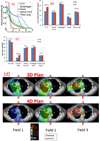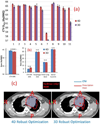Exploratory Study of 4D versus 3D Robust Optimization in Intensity Modulated Proton Therapy for Lung Cancer
- PMID: 26725727
- PMCID: PMC4834263
- DOI: 10.1016/j.ijrobp.2015.11.002
Exploratory Study of 4D versus 3D Robust Optimization in Intensity Modulated Proton Therapy for Lung Cancer
Abstract
Purpose: The purpose of this study was to compare the impact of uncertainties and interplay on 3-dimensional (3D) and 4D robustly optimized intensity modulated proton therapy (IMPT) plans for lung cancer in an exploratory methodology study.
Methods and materials: IMPT plans were created for 11 nonrandomly selected non-small cell lung cancer (NSCLC) cases: 3D robustly optimized plans on average CTs with internal gross tumor volume density overridden to irradiate internal target volume, and 4D robustly optimized plans on 4D computed tomography (CT) to irradiate clinical target volume (CTV). Regular fractionation (66 Gy [relative biological effectiveness; RBE] in 33 fractions) was considered. In 4D optimization, the CTV of individual phases received nonuniform doses to achieve a uniform cumulative dose. The root-mean-square dose-volume histograms (RVH) measured the sensitivity of the dose to uncertainties, and the areas under the RVH curve (AUCs) were used to evaluate plan robustness. Dose evaluation software modeled time-dependent spot delivery to incorporate interplay effect with randomized starting phases of each field per fraction. Dose-volume histogram (DVH) indices comparing CTV coverage, homogeneity, and normal tissue sparing were evaluated using Wilcoxon signed rank test.
Results: 4D robust optimization plans led to smaller AUC for CTV (14.26 vs 18.61, respectively; P=.001), better CTV coverage (Gy [RBE]) (D95% CTV: 60.6 vs 55.2, respectively; P=.001), and better CTV homogeneity (D5%-D95% CTV: 10.3 vs 17.7, respectively; P=.002) in the face of uncertainties. With interplay effect considered, 4D robust optimization produced plans with better target coverage (D95% CTV: 64.5 vs 63.8, respectively; P=.0068), comparable target homogeneity, and comparable normal tissue protection. The benefits from 4D robust optimization were most obvious for the 2 typical stage III lung cancer patients.
Conclusions: Our exploratory methodology study showed that, compared to 3D robust optimization, 4D robust optimization produced significantly more robust and interplay-effect-resistant plans for targets with comparable dose distributions for normal tissues. A further study with a larger and more realistic patient population is warranted to generalize the conclusions.
Copyright © 2016 Elsevier Inc. All rights reserved.
Conflict of interest statement
None
Figures



References
-
- Zhang XD, Li YP, Pan XN, et al. Intensity-modulated proton therapy reduces the dose to normal tissue compared with intensity-modulated radiation therapy or passive scattering proton therapy and enables individualized radical radiotherapy for extensive stage IIIB non-small-cell lung cancer: a virtual clinical study. International Journal of Radiation Oncology Biology Physics. 2010;77:357–366. - PMC - PubMed
-
- Stuschke M, Kaiser A, Pottgen C, et al. Potentials of robust intensity modulated scanning proton plans for locally advanced lung cancer in comparison to intensity modulated photon plans. Radiotherapy and oncology : journal of the European Society for Therapeutic Radiology and Oncology. 2012;104:45–51. - PubMed
Publication types
MeSH terms
Grants and funding
LinkOut - more resources
Full Text Sources
Other Literature Sources
Medical
Research Materials

